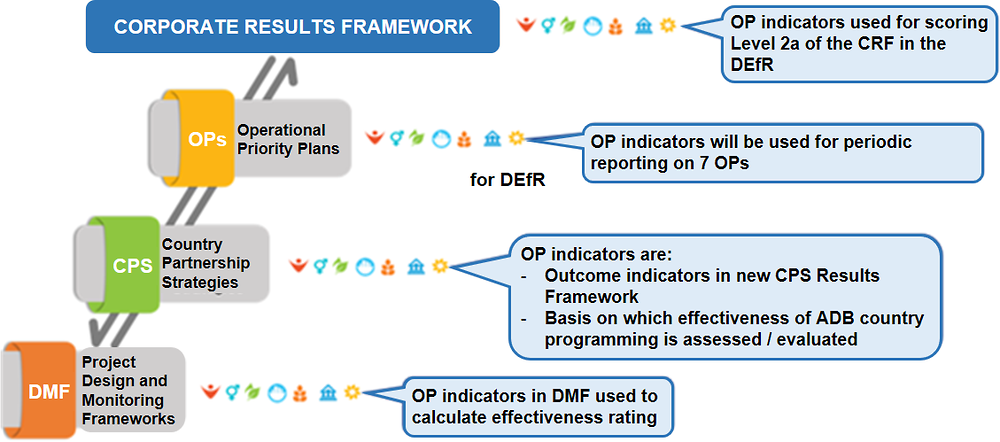The Asian Development Bank (ADB) introduced 7 operational priorities in its Strategy 2030. It needed to find a way to measure, monitor and report on the contribution of ADB-supported programming towards achieving these priorities. So ADB developed 99 standard indicators and revamped its vertically integrated results-based management system to cascade them down to the country and project levels and roll them back up for reporting.
Cascading standard results indicators across organisations

Abstract
Challenge
The Asian Development Bank (ADB) introduced 7 operational priorities in its new long-term strategic framework, Strategy 2030. These priorities focus ADB support on:
1. addressing remaining poverty and reducing inequalities
2. accelerating progress in gender equality
3. tackling climate change, building climate and disaster resilience, and enhancing environmental sustainability
4. making cities more livable
5. promoting rural development and food security
6. strengthening governance and institutional capacity
7. fostering regional co‑operation and integration.
ADB’s corporate results framework (CRF) has been aligned with its long-term strategy since 2008. The CRF is updated regularly and used as the primary tool for measuring and monitoring strategy execution. Although the CRF contained selected indicators for reporting on development results, the ADB faced a challenge: How to to measure, monitor and report on the contribution of ADB-supported programming towards achieving the far more comprehensive 7 operational priorities? The information generated needed to meet the needs of shareholders and the public, yet remain feasible for ADB staff and clients to provide.
Approach
ADB revamped its vertically integrated results-based management system. In collaboration with technical expertise across ADB, its results team:
developed 99 standard indicators for comprehensive measurement of operational priority results, including detailed methodological definitions for each indicator (key outcome-level indicators are included in ADB’s CRF at Level 2a)
updated project and country results frameworks so that the 99 indicators could be cascaded down to the level at which results are achieved
established a team and system to roll up and report on the results achieved
rolled out guidance and a help desk for project-level staff.
Figure 1. Cascading operational priority indicators across results frameworks

Note: OP = operational priority; CRF = corporate results framework; DEfR = development effectiveness review; CPS = country partnership strategies; DMF = design and monitoring frameworks; icons represent the 7 operational priorities.
Source: Asian Development Bank.
Results
Results contributing to the 7 operational priorities were successfully rolled up and reported in the ADB’s 2019 and 2020 Development Effectiveness Reviews.
The first Country Partnerships Strategy containing the new results framework approach was approved in January 2021.
The cascading of results has fostered broad ownership of the corporate strategy. Project teams are taking initiatives to design programming that will support achievement of the 7 operational priorities. The operational priority indicators provide specific information about which results to target.
ADB recognises that coherence and the vertical integration of progress reporting is a powerful communication tool. But deeper analysis of lower-level results is needed to gain better perspective. The annual development effectiveness review is therefore complemented by communication initiatives that articulate outcome narratives, such as the Together We Deliver series and interactive platforms such as ADB Results Reality.
Lessons learnt
ADB has achieved effective and timely progress in monitoring results at the corporate level, but there is room for improvement at the project, country, sector/thematic and operational priority levels. Based on recent experience, here are some lessons for enabling success:
When planning to build or expand results management systems, it is imperative to assess in detail not just the short-term but also the medium and long-term resource requirements. The ADB found that planning ahead to ensure resources are available for ongoing capacity building of staff and other users, including maintaining a help desk, is critical to success. The ADB’s rollout has taken longer than expected and is still in progress.
There is a trade-off between: 1) the standardisation and automation needed for a baseline level of quality and ease of data aggregation, and 2) the flexibility needed to foster innovation among users and provide room for capturing unique results. This needs to be recognised, and efforts must be made to strike the best balance possible.
The ADB had hoped to integrate a web-based solution into its existing portfolio monitoring platform sooner. This has been delayed because of a strategic decision to replace the current corporate platform. The lesson learnt here is to have contingency rollout plans. Existing systems, systems that are simple and inexpensive to establish, or manual approaches can be used to meet requirements while the ideal solutions are in development for future use.
Further information
Asian Development Bank, ADB Results Reality, https://resultsreality.adb.org.
Asian Development Bank, Managing for Development Results (MfDR) at the Asian Development Bank, https://www.adb.org/site/development-effectiveness/results-management-adb.
Asian Development Bank, Together We Deliver, https://www.adb.org/results/series/together-we-deliver.
Asian Development Bank (2021), “People’s Republic of China, 2021-2025 – Toward High-Quality, Green Development”, ADB Country Partnership Strategy, https://www.adb.org/sites/default/files/institutional-document/684081/prc-cps-2021-2025.pdf.
Asian Development Bank (2021), 2020 Development Effectiveness Review, https://www.adb.org/documents/development-effectiveness-review-2020-report.
Asian Development Bank (2020), 2019 Development Effectiveness Review, https://www.adb.org/documents/development-effectiveness-review-2019-report.
Asian Development Bank (2018), STRATEGY 2030: Achieving a Prosperous, Inclusive, Resilient, and Sustainable Asia and the Pacific, https://www.adb.org/sites/default/files/institutional-document/435391/strategy-2030-main-document.pdf.
OECD resources
OECD, Results in development co-operation, https://www.oecd.org/dac/results-development.
OECD, Guiding Principles on Managing for Sustainable Development Results, https://www.oecd-ilibrary.org/development/managing-for-sustainable-development-results_44a288bc-en.
Related content
-
 30 September 2024
30 September 2024 -
 Case study27 September 2024
Case study27 September 2024 -
 27 September 2024
27 September 2024 -
 16 September 2024
16 September 2024 -
 11 September 2024
11 September 2024 -
 10 September 2024
10 September 2024